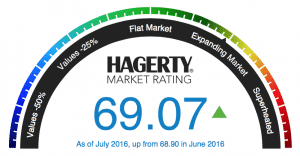5 Things to Remember When Restoring a Classic Car
However, there are important factors to take into consideration when choosing the car that you will spend hundreds of hours and thousands of dollar restoring. If you’re thoughtful, the project can bring immense satisfaction. Conversely, carelessness can result in wasted money and crushing disappointment.
The classic car market in North America at a glance
The Hagerty Market Rating uses a weighted algorithm to calculate the strength of the North American collector car market.
The Hagerty Market Rating measures the current status of the collector car market in terms of activity or “heat”; directional momentum; and the underlying strength of the market.
- For the first time in four months, the Hagerty Market Rating saw a sizable increase. At 69.07, July’srating is up 0.17 points from last month.
- Auction activity saw the biggest positive movement of any section this month and is at its highest since December 2015. The number of cars sold is up 2 percent over last month and the average sale price is up 1.8 percent.
- After its third consecutive drop last month, private sales activity increased, largely driven by an increase in the number of cars selling for above their insured values.
- Despite these increases, requests for insured value increases for broad market vehicles fell for the tenth consecutive month and are at a 26-month low.
- Insured value increases for high-end vehicles also decreased. This is their third consecutive drop and they are at a 17-month low.

According to Hagerty market rating data, auction activity for classic cars is up 2% for July.
1. Choose a car that will retain value
There are an infinite number of old cars for sale that need restoration. Most of these cars aren’t worth much, and will never be valuable no matter how carefully they’re restored. Don’t impulsively settle on a particular model. Do some research to determine which models are more valuable once they’ve undergone restoration. A car with appreciation potential might cost more to buy, but it’s important to remember that the cost of the car is only a small component of the total project cost.
2. Be wary of rust
Depending on where the car you choose has spent its life, you may find the car’s chassis has been eaten away by rust. Rust damage is time consuming to repair, and requires replacement of steel body panels. If you buy a rust bucket, be prepared to strip the entire chassis, sand blast every inch of metal, cut off sections that cannot be repaired and weld new replacement sections. If you’re lucky, you can buy replacement panels from aftermarket manufacturers. If not, you will have to fabricate them from sheet metal. Rust repair certainly isn’t for everyone, so it’s important to know what you’re getting into.
3. Find a car that starts
If you purchase a car that starts and runs, you significantly reduce the chances of expensive and time consuming mechanical repairs. Buying a non-running car that has been sitting for a decade can be a risky proposition. In the best-case scenario, you might need a new battery, starter or fuel pump. In the worst-case scenario, you may have a seized engine that will need to be rebuilt or replaced.
4. Ensure availability of replacement parts
A shortage of replacement parts can stop your project dead in its tracks. If you buy a car that is particularly scarce, there may not be aftermarket replacement parts available and used parts may be prohibitively expensive. To ensure your project goes smoothly and stays on budget, make sure replacement parts won’t be a major stumbling block.
5. Bring an expert
If you have a friend or acquaintance who knows about auto restoration, bring him or her along to look at a potential purchase. It’s a good idea to get feedback from someone with more experience in auto restoration, and choosing your car is the ideal place to start. Feedback from an expert with a critical eye can save you time and headache down the line.

